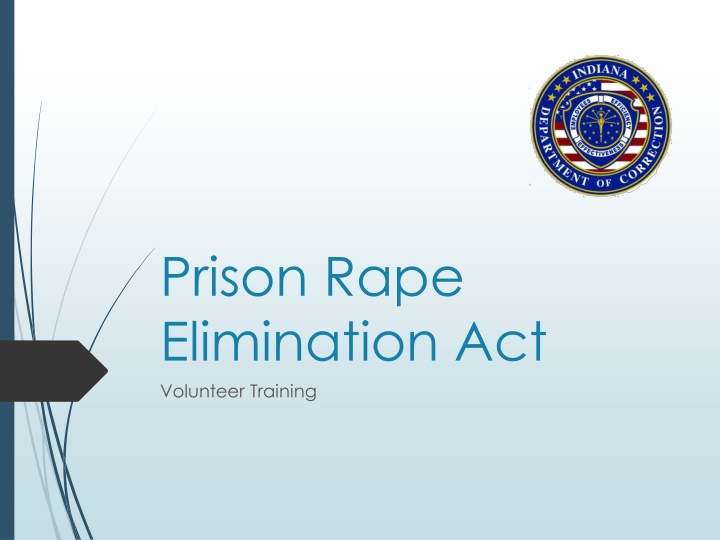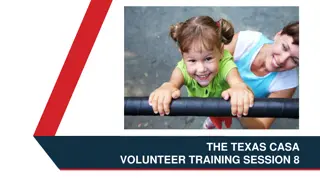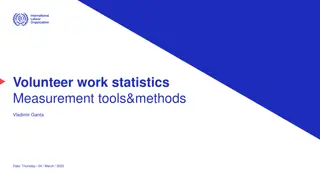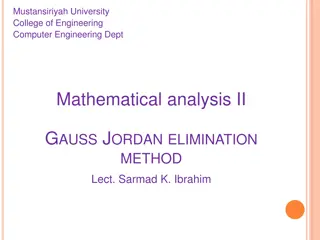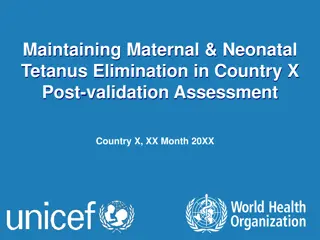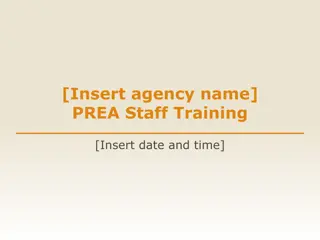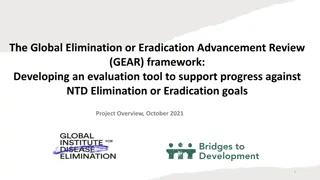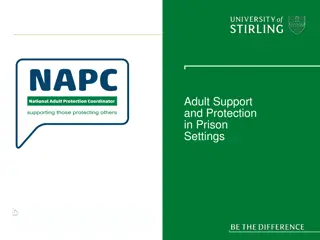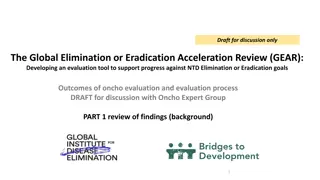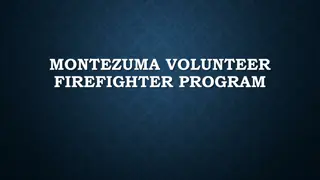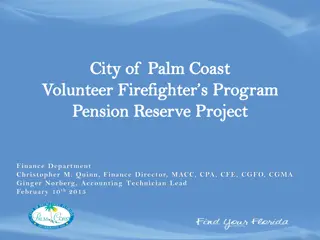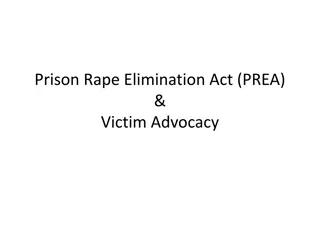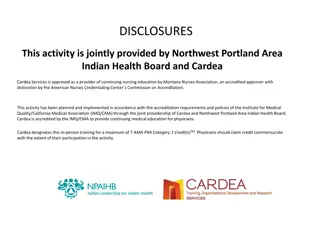Prison Rape Elimination Act (PREA) Volunteer Training Overview
The Prison Rape Elimination Act (PREA) Volunteer Training provides participants with essential knowledge on the Act's purpose, Agency's Zero Tolerance Policy, definitions related to sexual abuse and harassment, and procedures for preventing, detecting, and responding to sexual abuse in prison environments. The training emphasizes avoiding inappropriate relationships, communication skills, relevant laws on mandatory reporting, and the dynamics of sexual abuse. PREA aims to eliminate sexual abuse in confinement through national standards and resources.
Download Presentation

Please find below an Image/Link to download the presentation.
The content on the website is provided AS IS for your information and personal use only. It may not be sold, licensed, or shared on other websites without obtaining consent from the author.If you encounter any issues during the download, it is possible that the publisher has removed the file from their server.
You are allowed to download the files provided on this website for personal or commercial use, subject to the condition that they are used lawfully. All files are the property of their respective owners.
The content on the website is provided AS IS for your information and personal use only. It may not be sold, licensed, or shared on other websites without obtaining consent from the author.
E N D
Presentation Transcript
Prison Rape Elimination Act Volunteer Training
Performance Objectives After this E-learning participants will: Know what the Prison Rape Elimination Act is and its purpose. Know the Agency s Zero Tolerance Policy; definitions related to sexual abuse and sexual harassment; and the rights of offenders/students and staff under PREA.
Performance Objectives Know the dynamics of sexual abuse in a prison environment Know how to prevent, detect, report, and respond to sexual abuse and sexual harassment Know the common reactions of victims of sexual abuse
Performance Objectives Know how to avoid inappropriate relationships and how to communicate effectively and professionally. Know relevant laws related to mandatory reporting and age of consent. Know the difference in procedures for male vs female; juvenile vs adult; and LGBTI offenders/students.
Prison Rape Elimination Act The Prison Rape Elimination Act (PREA), a federal law enacted in 2003, was created to eliminate sexual abuse in confinement. In addition to providing federal funding for research, programs, training, and technical assistance to address the issue, the legislation mandated the development of national standards. The National Prison Rape Elimination Commission developed recommended national standards for reducing prison rape. The final standards became effective June 20, 2012, when they were published by the Department of Justice (DOJ) in the Federal Register.
Prison Rape Elimination Act The act also created the National Prison Rape Elimination Commission and charged it with developing standards for the elimination of prison rape. Those standards were published in June 2009, and were turned over to the Department of Justice for review and passage as a final rule. That final rule became effective August 20, 2012. In 2010, the Bureau of Justice Assistance funded the National PREA Resource Center to continue to provide federally funded training and technical assistance to states and localities, as well as to serve as a single-stop resource for leading research and tools for all those in the field working to come into compliance with the federal standards.
PREA Recommendations Establish a zero-tolerance standard for the incidence of prison rape in prisons in the United States. Make the prevention of prison rape a top priority in each prison system. Develop and implement national standards for the detection, prevention, reduction, and punishment of prison rape. These Standards were published in August 2012. Audits began in August of 2013.
PREA Recommendations Increase the available data and information on the incidence of prison rape, consequently improving the management and administration of correctional facilities. Standardize the definitions used for collecting data on the incidence of prison rape. Increase the accountability of prison officials who fail to detect, prevent, reduce, and punish prison rape.
The American Correctional Association (ACA) is an organization that sets national standards for prisons and provides research, training and accreditation to correctional agencies. The Indiana Department of Correction is accredited and adheres to the strict guidelines of the American Correctional Association.
In January 2003 the American Correctional Association Standards Committee finalized the adoption of several specific standards that are intended to significantly impact sexual violence. Working closely within and outside the corrections profession, the Standards Committee adopted these four (4) standards:
ACA PREA Standards 1. Revise intake screening requirements for all offenders to specifically identify those who are vulnerable or have tendencies to act out with sexually aggressive behavior. 2. Require that an investigation be conducted and documented whenever an assault or threat of assault is reported.
ACA PREA Standards 3. Require that offenders identified with a history of sexually assaultive behavior are assessed by mental health or other qualified professionals. Those with a history of sexual assaultive behavior are identified, monitored and counseled. 4. Require that offenders at risk for victimization are identified, monitored and counseled.
Zero Tolerance Policy The Department of Correction is committed to zero (0) tolerance for sexual conduct between staff, volunteers, contractors, contractual staff, visitors, official visitors or offenders whether committed by staff, volunteers, contractual staff, visitors, or other offenders. IDOC Policy 02-01-115
Zero Tolerance Policy In accordance with the Indiana Department of Correction Information and Standards of Conduct, all staff, contractual staff and volunteers have an affirmative duty to report all allegations or knowledge of sexual abuse, harassment, sexual contact, or any sexual conduct that takes place within the jurisdiction of the Department of Correction. IDOC Policy 04-03-103
DOJ Definitions The following are definitions used by Judicial Agencies to clarify sometimes confusing terminology. By understanding and using these commonly used definitions we will be able to address these issues in a professional manner.
DOJ Definitions Nonconsensual sexual act: Contact of a sexual nature by an offender against another person without his or her consent, or a person unable to consent or refuse.
DOJ Definitions Abusive sexual contact: Non-penetrative contact of a sexual nature against another person without his or her consent, or of a person who is unable to consent or refuse which includes intentional touching, either directly or through the clothing, of the genitalia, anus, groin, breast, inner thigh or buttocks of any person.
DOJ Definitions Staff/volunteer/visitor/offender sexual harassment: Verbal statements or comments of a sexual nature to an offender by an employee, volunteer, contractor, official visitor, visitor or Department representative or statements or comments of a sexual nature by an offender to another offender, employee, volunteer, contractor, official visitor, visitor or Department representative including: 1. Demeaning references to gender or derogatory comments about body or clothing; or, 2. Profane or obscene language or gestures.
DOJ Definitions Staff/volunteer/visitor sexual misconduct: Any act or behavior of a sexual nature directed toward an offender by an employee, volunteer, contractor, official visitor, visitor or Department representative, such as romantic relationships between staff and offenders and consensual or non-consensual sexual acts including: 1. Intentional touching of the genitalia, anus, groin, breast, inner thigh or buttocks with the intent to abuse, arouse or gratify sexual desire; 2. Completed, attempted, threatened or requested sexual acts; or, 3. Occurrences of indecent exposure, invasion of privacy or staff voyeurism for sexual gratification; Kissing and/or handholding.
Rights Of Offenders/Students And Staff Under PREA Offenders and students have a right to be free from sexual abuse and sexual harassment. Sexual abuse and sexual harassment are not part of the punishment and are counterproductive to rehabilitation and re-entry of offenders. All staff is responsible for providing a safe environment for staff and offenders.
Rights Of Offenders/Students And Staff Under PREA Offenders, students and staff have a right to be free from retaliation from other offenders/students/staff for reporting sexual abuse and sexual harassment. The Facility PREA Coordinator and PREA Committee will monitor for retaliation against offenders, students and staff that provide information about allegations of sexual abuse and sexual harassment. If you become aware of retaliation against any offender, student or staff, you must report it to your supervisor or facility executive staff immediately.
Dynamics of Sexual Abuse There are some commonalities of sexual abuse that may help us understand a little more about this unfortunate problem we face in corrections.
Dynamics of Sexual Abuse How/where does it happen? Causes (How) of sexual violence: Interpersonal conflicts Exploitive nature of inmate culture Pursuit of power Respect Sex as a commodity Forced abstinence
Dynamics of Sexual Abuse How/where does it happen? Where sexual violence happens: Multi-person housing Chapel Showers Kitchens Work areas Cells Day-rooms
Dynamics of Sexual Abuse Why do women engage in sexual activity (coercive and non-coercive) in custody? Inappropriate sexualization Sex as love or as a commodity Boundary issues Partner violence Fears about disclosure & reporting PTSD and re-traumatization Crisis and long-term treatment issues
Dynamics of Sexual Abuse Why do men engage in sexual activity? Desire Deprivation Companionship Favors or Benefits Protection Force
Dynamics of Sexual Abuse Why gender non-conforming offenders/students engage in sexual activity? Sex as love or as a commodity Boundary issues Fears about disclosure & reporting
Dynamics of Sexual Abuse Why gender non-conforming offenders/students engage in sexual activity? History of previous confinement and/ or longer sentences Desire Favors or benefits Protection Force
Dynamics of Sexual Abuse Common responses of female victims in custodial settings: At risk for unhealthy relationships with authority figures, based on perceptions of their power to harm Difficulty adjusting to coercive, restrictive environments Lack of right to privacy, cell searches, bodily searches may replicate past abuse Concern with how reporting may interrupt relationships
Dynamics of Sexual Abuse What happens when the institution doesn t respond appropriately? More likely to experience physical trauma Retaliation and/or retribution Lack of autonomy and safety General distrust (staff, reporting structure, investigation, prosecution) Feelings of disorientation and anxiety Sharing or talking about feelings may be a safety risk for an offender
Dynamics of Sexual Abuse What happens when the institution doesn t respond appropriately? Isolation may be a relief but it could also cause further trauma Increased anger may cause acting out Complex nature of consent can lead to self-blame Multiple traumas
Detecting Signs of Sexual Abuse The signs of sexual assault have both physical and mental attributes. Keen observation is required by staff to detect possible abuse or perpetration of the crime. Remember, in most cases males do not report sexual assaults. Therefore, staff must pay attention and report suspicions of possible sexual assault victims. Observable signs of sexual assault include:
Detecting Signs of Sexual Abuse Observable Signs Of Sexual Assault: An offender who has difficulty, or pain while walking An offender who has difficulty, or pain while sitting An offender who has unusual bruises or marks that may indicate assault
Detecting Signs of Sexual Abuse Observable Signs Of Sexual Assault: Bloody clothing, especially in the seat of the pants or underwear Bloody linen Frequent request by the offender to see health care staff Frequent request by the offender for laundry exchange
Detecting Signs of Sexual Abuse Environmental Signs Of Sexual Assault: Groups of offenders approaching a single offender in common areas or in cell or bed areas Rumors from offenders about an assault that is going to or has occurred Unaffiliated offenders who participate in gambling or receive services or goods with organized offender groups
Detecting Signs of Sexual Abuse Environmental Signs Of Sexual Assault: Single offenders who defy the norm of the unwritten rules held by offenders, such as snitching. A decrease in interest in the offender s normal activities of daily life. An offender s withdrawal from social activities. An abrupt or unwarranted attitude change by an offender. Offenders who loiter or congregate in blind spots
Your Responsibilities in the IDOC Sexual Assault Prevention Plan Policy 02-01-115 Sexual Assault Prevention, Investigation, Victim Support and Reporting provides all staff with the procedures for the Department s sexual assault prevention plan. All staff, contractors, volunteers, offenders, and students are responsible for reading and understanding this policy and its content.
Sexual Assault Prevention Plan Summary Offender/Student Education: Offenders/students are provided information about the agency sexual assault prevention plan and how to report an incident within 24 hours of intake Pamphlets and video information is provided both verbally and in written format. Offenders/students that are not English language proficient will be provided translation services Offender/students that are illiterate or visually impaired will have the material read to them by staff.
Sexual Assault Prevention Plan Summary SVAT Sexual Violence Assessment Tool An assessment form that is completed at intake to the agency based on the offender record and an interview with the offender. Predicts if an offender/student is a likely aggressor or likely victim based on several factors. Assessment completed within 24 hours of intake into the department, 72 hours of intake into a facility Reviewed annually and every 6 months for LGBTQ offender/students Used to keep offenders separated that are a high risk for being an aggressor or a victim
Sexual Assault Prevention Plan Summary PREA Committee Meets monthly and established by the facility Superintendent Consists of the facility PREA coordinator, investigators, medical, mental health, and executive level staff Review allegations once the investigation concludes within 30 days (except unfounded).Looks for any need to change procedures, add staff or cameras, proper staff response, etc. Monitors for retaliation for 90 days after a report is made Review PREA flags
Sexual Assault Prevention Plan Summary Detection Staffing Plans: Providing the appropriate staffing plan can assist in the deterring and detecting sexual abuse. Juvenile have a 1-8 ratio during waking hours and 1- 16 during sleeping hours. Unannounced Rounds by Supervisors
Sexual Assault Prevention Plan Summary Detection - Video Monitoring systems: Provide assistance in investigations and deters sexual abuse. Helps cover areas when staff are not present.
Sexual Assault Prevention Plan Summary Detection - Observation: All staff needs to watch for signs of sexual abuse and report any suspicions to a supervisor.
Sexual Assault Prevention Plan Summary Reporting - Offender/Student: Can make a report to any staff Can make a report by calling the investigations hotline on the offender phone system Can make a report to a victim advocate agency by calling an external hotline on the offender phone system or emailing through the J-Pay kiosk
Sexual Assault Prevention Plan Summary Reporting - Offender/Student: Can make a report by writing, anonymously if they wish, to any IDOC staff or victim advocate or file a grievance Offender/student family members can make a report on their behalf by calling the facility, calling the Sexual Assault Hotline on the IDOC website or emailing IDOCPREA@idoc.in.gov
Sexual Assault Prevention Plan Summary Reporting - Staff/Volunteer/Contracted Staff: Can report to any staff, in private if they wish Offender family/friends can call the IDOC sexual assault hotline (877-385-5877) or email a report to IDOCPREA@idoc.in.gov
Sexual Assault Prevention Plan Summary Response Sexual Assault Response Team (SART): Each facility will have a SART with custody members assigned as first responders on each shift. Other members are: FPC, Medical, IA. Members of the SART are trained with a specialized curriculum that covers more in-depth information about first responders, investigations, forensic exams, prosecution and victim advocacy.
Sexual Assault Prevention Plan Summary Response SART Goals: 1. Meet the needs of the victim with crisis intervention and support services. Provide a comprehensive forensic examination for sexual abuse victims. Provide a joint, effective, sensitive approach to victims of sexual assault. Document and preserve forensic evidence for potential prosecution. Conduct investigations of the crime from notification through prosecution. 2. 3. 4. 5.
Sexual Assault Prevention Plan Summary Response Investigations: Conducted by IDOC Internal Affairs and/or Correctional Police Officers Assisted by Indiana State Police as needed for DNA Evidence Child Protective Services assists with victims under 18 Follow the National Protocol for Sexual Assault Medical Forensic Examinations - Adults/Adolescents (DOJ)
Victim Support If an allegation is of actual sexual conduct, the victim shall be referred to the facility s Health Care staff for examination in accordance with health care services directives (HCSD 2.30 and JHCSD 2.30) and the Sexual Assault Manual. Victims of sexual abuse have timely, unimpeded access to quality medical and mental health services free of charge following an incident of sexual abuse, whether or not they name an abuser.
